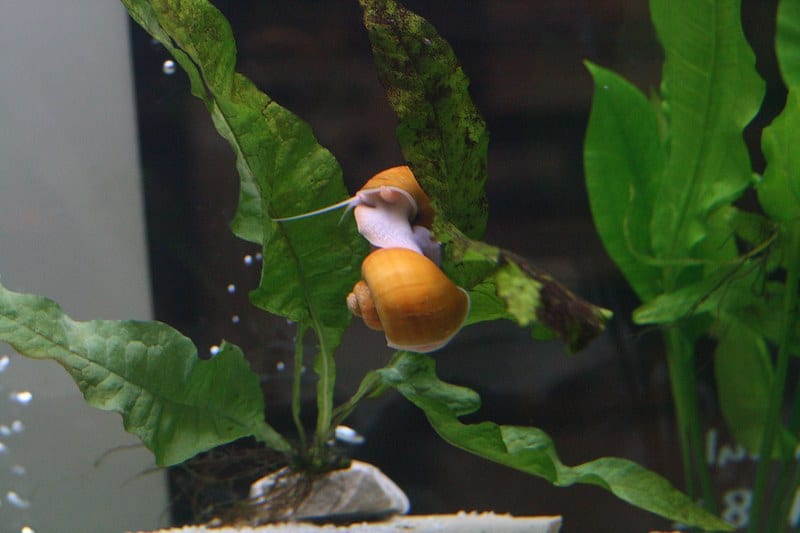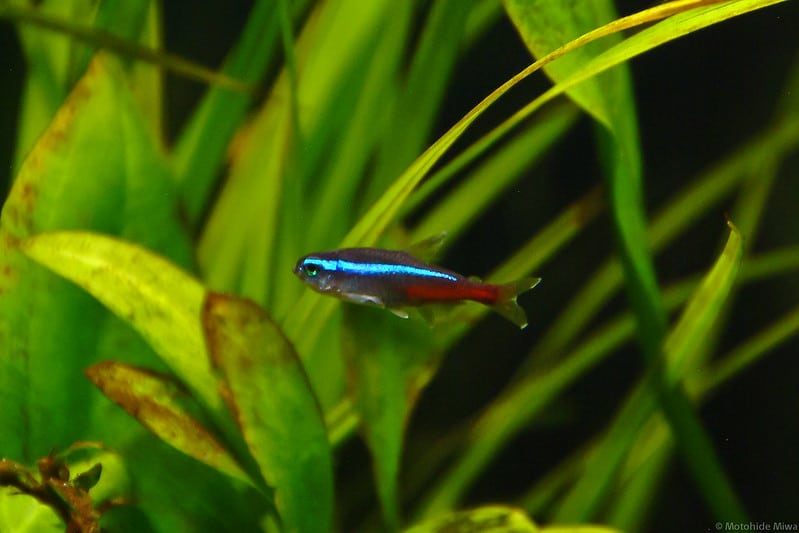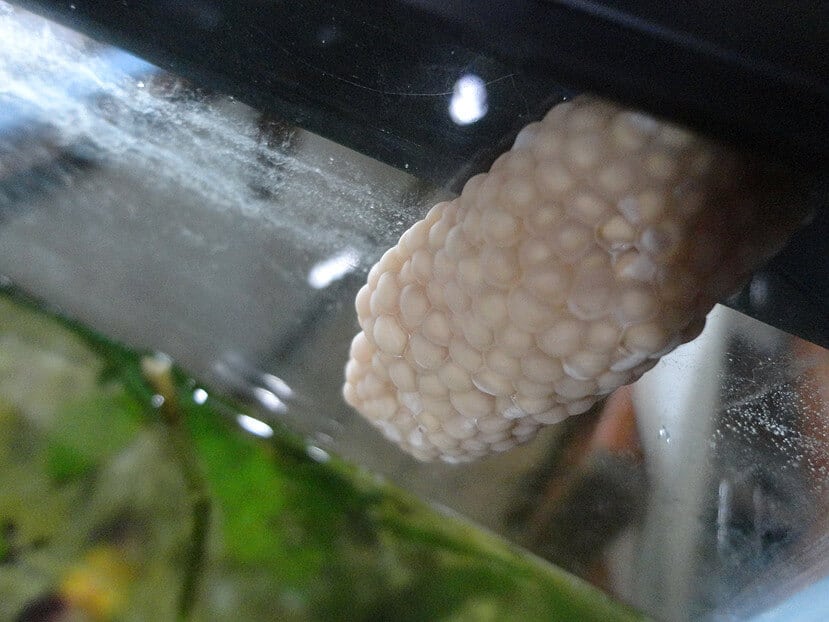Whether you are a beginner or an experienced hobbyist, adding a mystery snail to your freshwater home aquarium is often a good idea. They are one of the most popular snail species among tank owners.
They are slow and peaceful herbivores that will feed on any algae, thus helping keep the environment clean. These snails will happily feed off algae on the glass or rocks as they live out their one-year lifespan.
If you are planning to buy a mystery snail, we recommend reading this article so you can understand more about this species. From their appearance and behavior to tank conditions and breeding! So, what are you waiting for?
| Category | Rating |
| Scientific Name: | Pomacea bridgesii |
| Common Names: | Mystery snail, apple snail, golden snail |
| Care Level: | Easy |
| Temperament: | Calm and peaceful |
| Size: | Up to 2 inches |
| Color: | Various from black, white, blue, brown, purple and gold |
| Life Expectancy: | Up to 1 years |
| Diet: | Herbivore |
| Family: | Ampullariidae |
| Minimum Tank Size: | 5 Gallons |
| Tank Setup: | Planted tank with moderate vegetation |
Table of Contents
Quick Overview

Mystery snails are part of the Gastropoda class and have a lot of different names. This includes mystery apple snail and golden mystery snail, but you should know that the right scientific name for this species is Pomacea bridgesii.
In the wild, they can live up to a year and feed on dead plants and detritus. One of its most unique features is their complex eyes, which can regrow if they are ever damaged.
When buying these snails, you should be careful and choose the right ones. Take some time to watch them inside the store, picking only snails that you see moving or attached to surfaces. After all, you wouldn’t want to come home with an empty shell!
Typical Behavior
In general, this species is extremely peaceful, and this makes them perfect for beginners to keep in a community tank. They will spend a lot of time simply feeding on algae build-up and not interacting much with anything else.
They can protect themselves from aggressive fish by retreating into their shell. With that said, we still recommend housing them with other peaceful species too. This allows the snails to be more active, thus helping you clean algae more effectively!
While they are slow-moving, like most snails are, you can sometimes observe them sliding down the glass. This might provide some entertainment in the tank, but don’t expect too much activity from a snail.
Appearance

In terms of appearance, mystery snails come in a range of colors, with black and brown being the most common. You can also find gold and ivory snails that can provide a pop of color in your aquarium. Shell patterns also vary, including solid, banded, and gradient ones. It all comes down to how colorful and exciting you want your snail to be!
This snail species can grow up to 2 inches, which means you can keep them in any-sized tanks. A unique part of their body is the operculum. This is the plate that can close their shell and can be a good indicator of the snail’s health. It will fall off when the snail dies.
They also have two tentacles on their head that are used to navigate the environment and locate food. Underneath, there are another pair of tentacles for feeding and a mouth. Mystery snails do look like the general freshwater snail.
Habitat and Tank Conditions
You will find the natural habitat of these snails in the ponds and rivers of Paraguay, Brazil, and Bolivia. However, they are starting to spread across the globe to North America too. They are native to swamp-like regions where they can feed on dead plants.
Even in the wild, they can quickly hide in their shells in case of any predators. But these snails still have to be wary of creatures that can break their shell.
Best Tank Conditions for Mystery Snail
You can recreate their habitat in a home aquarium to make your mystery snail as happy as possible. Simply add plenty of vegetation that can function as a natural food source. Try using Java Fern and Java Moss for a common choice. These plants will also make the tank look more natural and beautiful.
Snails like this species like to swim out when they can’t find any more food underwater, which means you should place a lid on the tank. This can help prevent accidents where they fall out of your aquarium.
While they are adaptable and hardy, you should make sure there are no sudden changes in water condition. The best environment would be one with moderately moving waters that are oxygenated.
In terms of water requirements, maintain a pH level of 7.6 to 8.4, the temperature of 68°F-84°F, and kH 12-18 for water type. It is crucial to keep the pH level high, as acidic waters can dissolve their shells and make them more vulnerable. You can also supplement calcium to help them keep strong shells!
For the substrate, we recommend adding hard elements like pebbles and sand so they can move around easily. These snails don’t need a specific type of substrate, so you can just adjust to the other species and what they may need.
Tank Size Recommendation
What about the tank size? The good news is the mystery snail is able to thrive in almost any size of the tank. You can easily introduce them to an existing community tank of around 5 to 10 gallons. Of course, they prefer larger tanks.
When it comes to keeping multiple mystery snails in the same tank, there should be only 1 or 2 of them in every 5 gallons of water. This will ensure not only enough food for them all but also space to move freely.
Mystery Snail Tankmates
As we have mentioned previously, mystery snails do not interact with other fishes. Despite having a shell to hide in, you should not house them with aggressive and predatory species. Do not put these snails with Cichlids or Crayfish. Otherwise, your snail might be eaten!
Suitable tankmates for the mystery snail include Tetras and Guppies, who will leave them alone. Other peaceful shrimps are also a good option, from Amano Shrimp to Ghost Shrimp alike. These species will not harm one another.
You can also house them with other Gastropods or snails. Ramshorn Snails and Nerite Snails are some examples that have proven to be great tankmates for your mystery snails.

Can You Keep Mystery Snails Together?
Yes, you probably already guessed the right answer to this question. Mystery snails can get along with their own kind, provided you give enough space for them to roam and grow.
There is no need to worry about these snails fighting each other or competing for their own territory. However, you should still make sure that you do not overstock them. 2 snails per 5 gallons is the maximum, although 1 is preferable.
When there is not enough space, you will compromise the health of the mystery snails. For example, lack of food can lead to defects and damaged shells. That is not something you want happening in your tank, right?
Food and Diet
Mystery snails are used to eating dead plants and algae, which means feeding them is not a problem at all. If your tank has dense vegetation, these plants will naturally shed and become a natural food source for your snail.
In addition, any algae that grow will provide plenty of nourishment for them. In fact, their algae-eating nature is one of the reasons aquarists adore this little species! They will keep your tank clean without complaint.
On top of this natural diet, you can add supplements to ensure that they get other minerals. We recommend tablets and flakes that can sink to the bottom. Feel free to mix up their diet by giving them blanched leafy greens.
Also, don’t forget not to overfeed! It is important that you don’t leave these foods uneaten for too long. It may lead to murky and dirty waters that may endanger the health of all those inside the tank.
Caring for Mystery Snails
Just like with any other species, you should do your best to keep your tank inhabitants healthy. For snails, give extra attention to their shells so they are not damaged! You can do this by ensuring that the pH remains high and supplementing them with calcium.
A common parasite that could attack mystery snails is the Rat Lungworm. The larvae form often lives on snails as they grow into an adult. However, these are usually found in the wild so you do not have to worry about them inside a tank.
Meanwhile, wild-caught snails may often attract and bring Grub Worms. These are small and white that can rapture, releasing parasites into the aquarium. They can cause problems for other fishes as they encyst their flesh and remain persistently there.
This is why you should check the mystery snail’s shells before adding them to your tank. With most of these issues, you can patch up their shells. But this can be risky and should only be done if you know what you are doing.
How to Breed Mystery Snails

A lot of freshwater species cannot be bred at home, but the mystery snail can breed quite easily! This lets you have more snails without buying more of them.
Note that you should have male and female snails in order for them to breed. Fortunately, there is no need for you to do anything for them to mate. The female snails will lay eggs when she is ready, leaving them in a cocoon that you can remove (if you don’t want baby snails).
These baby snails will fall down the aquarium and slowly grow into adults of their own. They eat just as their parents do, so you don’t have to worry about that either.
It may help to lower the water level as you give these snails enough room above water to lay eggs. Mystery snails also spawn more easily when there are enough food sources. So, that’s another thing to focus on.
Should you get Mystery snails in your tank?
We have covered some of the most important aspects of keeping a mystery snail. It all comes down to your decision and individual tank needs. Before buying them, think about the current ecosystem of your freshwater aquarium.
Does it have plenty of plants and vegetation? What about the other species that currently live there? They should be relatively peaceful and harmless towards mystery snails. This will ensure that the snails can live while feeling safe.
These snails are also easy to maintain and do not require much in terms of care. Without specific needs, the mystery snail can be the perfect choice even for beginners!
Furthermore, you may want to get mystery snails if you are looking for algae eaters that can help keep the tank clean. They will make your job in cleaning off algae much easier. Indeed, you can almost never go wrong with this species. Not to mention that you can easily find them in any regular aquarium store.






